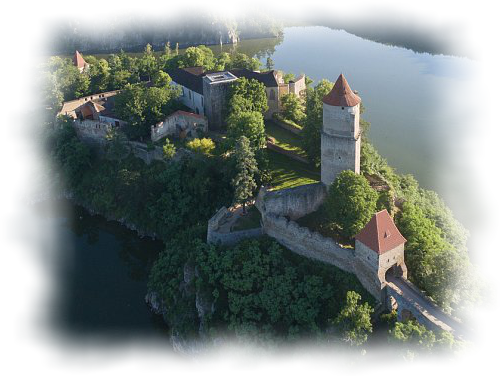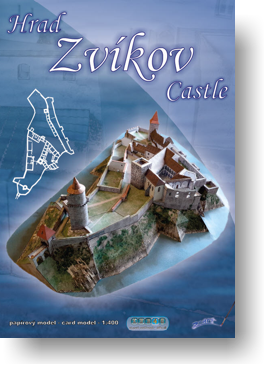

ABOUT ZVÍKOV CASTLE
Zvíkov Castle is located in the Czech Republic above Orlická přehrada (dam), on a steep rock above the former confluence of Vltava and Otava rivers before the dam was built. Since 1978, the castle has been owned by the state and is managed by the National Heritage Institute.
HISTORY OF THE CASTLE
The rock above the rivers´ confluence has always been the perfect place to build a defense area. The remains of the old Celtic oppidum were used to build the Hlíza Tower in 1220´s, during Přemysl Otakar I. reign. Later, a royal castle was built by the Přemysl family, who owned the castle until 1306 when Václav (Wenceslas) III was assassinated. The original name Zvíkov was temporarily changed to Klingenberg (the German form) around 1250. During the time, the later king Přemysl Otakar II and his suit, led by the Prague bishop Nicolas, were arrested in the castle.
The caste had strong power in the surrounding areas, which led to disputes with the neighbor family of Rožmberk, who made attempts to gain influence. After all the male members of Přemysl family died off in 1306, the Rožmberks took their chance and persuaded the king Rudolph of Habsburg to entrust the castle into their care. The Rožmberks were a very strong and well respected family and the castle remained in their ownership. In 1334-1336, Charles IV attempted to take power, but he failed mainly due to financial reasons, and the castle, as well as 32 villages in the region remained in Rožmberk´s heritage.
In early 15th Century, the Hussite Wars started. The burgrave was Jan Hájek of Hoděnín, a man with diplomatic skills, who came to an agreement with the Hussites and they eventually did not even attempt to conquer the castle. After the wars ended, the castle fortification system was improved and its safety allowed several political meetings in 15th Century.
The Rožmberk´s era ended in 1473 when Jindřich of Rožmberk gave the rights of managing the castle and the nearby Milevsko monastery to his uncle Bohuslav of Švamberk. The Švamberk family owned the castle till the confiscation after the Bílá hora battle in 1620. They had a great influence within the noble society of those times. The castle became the place of numerous social and political events at the end of the middle ages and the beginning of the Renaissance era. Bohuslav of Švamberk organized many of the castle´s improvements – beautiful wall paintings in the halls, building the chapel, and improving the buildings. During the Bílá hora battle and the previous rebellions, the castle´s residents never gave up – there was a large military unit defending the castle. However, in 1622, two years after the battle, Zvíkov surrendered, which meant the end of its famous era. The castle was plundered by the emperor´s soldiers. The next owners were the Eggenberg and then the Schwarzenberg families, however, they did not use the castle. In 1751, a huge fire destroyed most of the castle, which slowly dilapidated until 1840, when some attempts to repair it were made – however, the owners, Schwarzenberg family, had the neary Orlík castle as their main seat and Zvíkov was not their priority. This family owned Zvíkov till 1948 and now, it is owned by the Czech state and managed by the National Heritage Institute.
ARCHITECTURE OF THE CASTLE
Once you start making this model, you travel seven centuries back in time. You will start by building the Royal Palace and the Hlíza Tower. The rectangular Hlíza Tower is 20 metres high and it is the oldest part of the castle, coming from 1220´s. On the southern and western sides, it is covered by stone blocks in 44 equal rows, while in the northern and eastern sides it was built with smoothly carved stones – this shows it was meant from the beginning to add buildings from these sides. However, even before, the residents lived in tower. The proof is a hall on the first floor. This room served as a deposit place for the Royal crown later. This is why that room is today called The Royal Hall. In 1234, when the first document about the castle was written, the tower was in such a state it was able to accommodate the Royal burgrave Konrád of Janovice. The interesting fact about the tower is, some of its stones have signs of their makers carved in – this lead to confusion in 19th Century, when the historian thought it was the rune language of the Marcomanni and therefore they name the tower The Marcommani Tower.
Another building phase begun around 1250 during Vaclav I reign. The Western Wing and the fortification walls were built. The walls were very long, over 500 meters, and their building took many years. It was finished after Václav´s death when his son Přemysl Otakar II took the power. He also finished building the Arcade Yard and the Royal Place. The southern side of the palace is connected with the eastern side of the Hlíza Tower and the Wenceslas Chapel is located there. The chapel was built in 1270 and it is one of the few objects never damaged by battles, fire or renovations. The interior of the chapel is historically the most precious part of the castle. Even though the original paintings did not last, the remaining 15th Century late Gothic paintings are a unique sample of Medieval art.
The dominant part of the castle is Hláska Tower. It is 30 meters tall, oval with a sharp edge on the southern side facing the access road. The entry to the castle is through the Sand Gate (Písecká brána). The tower was lower when it was built and some height was added in 1554. The stone bridge above the defense trench was built in 1777.
TOUR IN THE CASTLE
You can walk around the castle without the guide, with texts in several languages. The main point of interest is the Royal Palace. The first floor exhibition shows local archaeology finds. You can walk down to the basements or up to the palace. In the north-east, there are terraces with astonishing views to the dam and Otava and Vltava rivers. You can explore the rooms and halls. There is also a model of the castle, as well as historical furniture, Renaissance paintings, altar, you can climb the 73 steps of Hlíza Tower and finish the tour by exploring the late 13th Century chapel and its wall paintings and vestry.
Text: Miroslav Konopka, translated: Simona Čechalová
 Zvíkov Castle 01 |
 Zvíkov Castle 02 |
 Zvíkov Castle 03 |
 Zvíkov Castle 04 |
 Zvíkov Castle 05 |
 Zvíkov Castle 06 |
You can order in our e-shop.
Back


